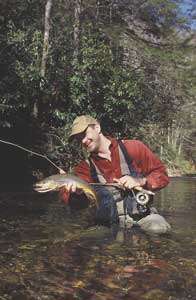
Most anglers I know are photographers. As catch-and-release continues to gain in popularity, a camera increasingly becomes an integral piece of required tackle.
Aside from a reliable witness, a picture is often the only evidence to back up your claim of a big catch. To me, that is worth more than 1,000 words any day.
If you practice catch-and-release, and the only things you can bring back from a fishing trip are photographs, you want them to be the best possible. Here are some tips on how to improve the pictures from your next outing.
Use a wide-angle lens or “zoom out” with your point-and-shoot zoom lens.
A wide-angle lens exaggerates (yes, I said “exaggerates”) objects in the foreground and understates the background.
Similar to the side-view mirrors on a vehicle, a wide angle of view visually distorts perspective so any object near the front of the lens, such as a fish, will look much larger relative to other objects further away.
For the next “hero shot” of your buddy holding his big fish (or you holding one), use a wide-angle lens, zoom out then get as close as possible.
A wide-angle lens also will include more of the surroundings in the picture, giving it greater context.
The photograph will tell more of a story, such as glimpse of the river or lake, the season, weather conditions, etc. — details that may be forgotten years later when the memory begins to fade.
I like to crouch down and get to eye-level with the proud angler — or even lower still. With a wide-angle lens, it is essential that the photographer gets close to his subject. When you think you have just gotten close enough, get closer still.
A polarizing filter can be a useful addition to camera equipment. Just like polarized fishing sunglasses, a polarizing filter removes glare from any non-metallic surface, including the water, wet leaves, and a fish being held out of the water.
This function of polarization preserves vivid color and detail that’s being masked by the sun’s glare. It also will darken and color-saturate hazy blue skies.
A polarizing filter works best when it is being used at a 90-degree angle from the direction of the sun.
If you’re pointing the camera directly at or away from the sun, the polarizing filter will have no effect.
Use the camera’s flash whenever possible. Modern flash technology is a marvel and can balance natural light with the flash output to give fish portraits balanced, even lighting.
Flashes can lighten shadows on an angler’s face created by the high angle of the mid-day sun and the brim of a hat.
Most cameras have a fill-flash option, which illuminates darkened shadow areas without overexposing the rest of the picture.
Keeping a camera safe and dry can be a difficult task during a fishing trip.
Hard-shell Pelican cases or soft cases such as Watershed (my favorite) will protect a camera gear from rain or the accidental drop in the water. These cases come in several sizes to accommodate a small point-and-shoot digital camera to an SLR with extra lenses and accessories.
If you’re taking a picture while standing in water or the edge of a boat, a camera strap draped around the neck is good insurance if you have the tendency to drop things.
If you’re planning to release your catch, you need to photograph and return the fish to the water as soon as possible — for the sake of the fish’s survival.
If you plan to keep your fish, you should still photograph it quickly so it’s fresh-looking and natural.
Dead or stiff fish rarely make good photography subjects — nor are they how we want to remember them later.
Fishing will take anglers to some beautiful water in some of the best light of the day — early and late. Recording the moments and the fish can bring both joy and the excitement long after the fishing trip ends.
You might discover the biggest challenge is knowing when to put the fishing rod down and pick up a camera.



Be the first to comment